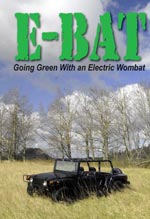
E-BAT

E-BAT: Going Green with an Electric Wombat. Story and photos by Dan Burrill. May/June 2010 edition of Kit Car Builder: www.kitcarclub.com Click on a photo for an enlargement.
This "E-Bat," as it's called by Wombat founder, Karl Kanthak, is his latest creation, and it was built as a turnkey for a customer in Puerto Rico. The Wombat kit is a custom designed, steel-framed fiberglass body kit that fits on a classic VW Beetle chassis, giving it the off-road ability to match its tough looks. It takes its styling cues of course from military utility vehicles. Designed to fit on a standard VW Bug pan, it is technically a rebody, meaning that the core mechanicals of the donor car are not modified, and the new body is designed to fit a stock chassis.
For this E-Bat a 1971 VW chassis was sourced, stripped and rebuilt with front disc brakes. Mike Locicero at Import Transmission Exchange completed the transmission rebuild. This particular subframe was modified for the unique needs of the electric conversion prior to its bonding into the body. Special racks were fabricated in the rear engine area for six batteries, the controller, and other electrical components. Four batteries were mounted in the rear floorboard area, and three more in the front trunk area.
Also, the E-Bat is fitted with a custom wiring harness that incorporates four-way flat towing plugs at the front and rear to function as either a "towee" or "tower" vehicle.
"The car is kind of spooky to drive," said Kanthak. "There are only three gauges on the dash, a conventional speedometer, a volt meter and an amp meter." Turn the "ignition" key to "on," and there's only a click in the motor area. Power is controlled by the gas pedal that operates a potentiometer to control engine speed by varying the voltage. There is a slight, high pitched whine for a second or two as the motor begins to spin, with all of the torque available immediately, and then you are rolling along silently with only tire, suspension, and wind noise. These electric vehicles use a clutchless system even though you can still shift gears. The flywheel, throw out bearing, clutch, pressure plate are not even installed. Lifting off on the throttle pedal is all that is needed to shift gears. You can upshift to go to higher speeds if want to or you can keep it in second or third gear and drive it like an automatic since more amps are used in the higher gears. The goal is to use the least amount of amps possible to achieve more range on a charge. With this kit top speed will be 65 to 75+ mph with a range of somewhere between 20 to 60 miles depending on usage. With a Quickcharger, you are looking at eight to 12 hours to charge the car if you run it down during the day. The Quickcharger is a smart charger, so it shuts off once the batteries are topped up which will help the batteries last much longer. To get a little idea of what it might cost to run this electric vehicle we did a little figuring based on the cost of electricity in the Pacific Northwest. The cost of a charge, of course depends on how much you pay per kilowatt hour where you live. We pay about nine cents/KWH, so running the E-Bat every day for 30 miles (a typical commute), we figured it would be around $20 a month, or less than two cents a mile. Compare that with what you pay for gas. The only real maintenance requirements are keeping the terminals clean and occasionally adding water to the batteries. Battery life is estimated at approximately five years. There is a lot of development on lithium batteries right now, that promise to greatly improve EV range, but they are expensive. We don't need to build a case for electric kit cars, but isn't it an interesting alternative consideration for short-trip vehicles. Think about the grins every time the car goes by a gas station. We don't normally like laundry lists of equipment, but for the sake of understanding this technology here's a list of the components for the electric system that was installed in this car:
Wilderness Electric Vehicles |



